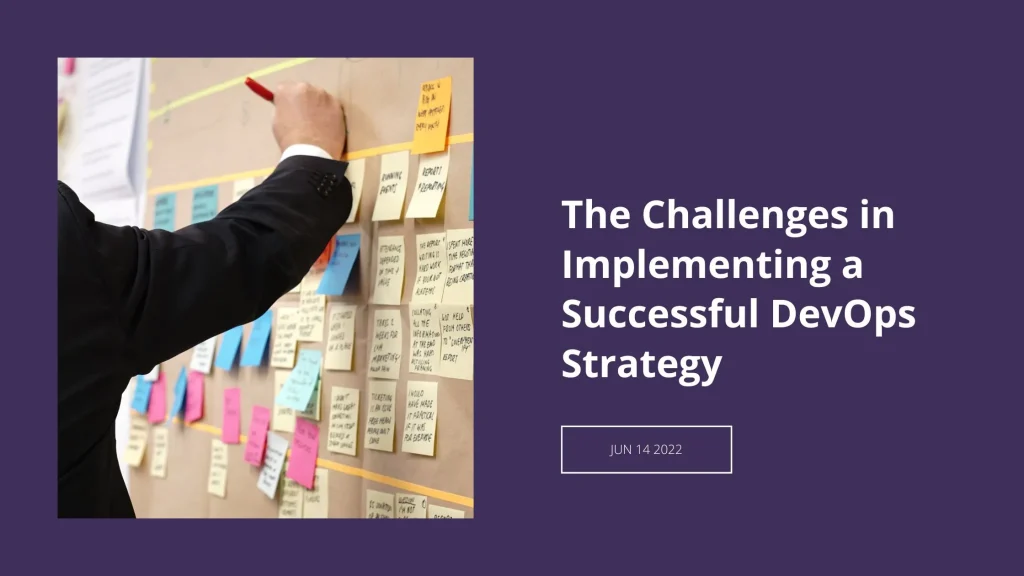The Challenges in Implementing a Successful DevOps Strategy

DevOps implementation Approach
The challenges in implementing a successful DevOps strategy can be significant, impacting an organization’s ability to enhance collaboration and productivity. Understanding these challenges is crucial for any enterprise striving to adopt a DevOps culture. DevOps which emphasizes the integration of development and operations, benefits enterprises to foster better collaboration and information flow among various cross-functional teams thus breaking the conventional siloed structure and enhancing the overall efficiency and productivity.
Having seen and understood the benefits of DevOps in action most the enterprises have adopted a full-fledged DevOps culture. However, many organizations are yet to adopt a DevOps culture driven by factors like fear and suspicion and these companies would be lagging behind their peers and rivals, and they would also be burdened with an overwhelming pressure to stay in this competition.
You can use a gradual and steady approach to implement DevOps rather than getting it done in one go. Implementing a DevOps strategy or to be more precisely a successful DevOps strategy can be quite challenging. Let’s see some of the common challenges to implementing a DevOps strategy.
Overcoming the challenges in implementing a successful DevOps strategy for better performance
1) Migrating from Traditional Infrastructure to Microservices
Traditional infrastructure and legacy applications may present you with several problems and challenges due to a lack of compatibility, stability, and support. If you are still continuing to use the traditional and complex architecture-based infrastructure, you may find yourself in a vicious circle as you will lag behind the competition secondly you cannot deploy the latest disruptive technologies due to compatibility and configuration issues with your legacy systems.
To accelerate the pace of the software development life cycle and enhance your agility to meet the ever-changing customer requirements as well as drive the path to continuous future innovation it is very much essential that you use infrastructure as a code in conjunction with microservices architecture. Microservices may be associated with increased operational loads and hence it is of utmost importance to have a good grasp and understanding of automation, continuous integration and continuous delivery/continuous deployment (CI/CD) practices, configuration management, etc.
2) Integrating DevOps Tools Based on Different Domains
DevOps means different things to different departments. You have people based on different teams and departments using a wide variety of applications and tools, thus posing a significant challenge for continuous development, testing, and deployment. Continuous integration is a linchpin requirement and demands that all the tools must be properly integrated and synced. Teams may require to get adapted to new technologies which they may not be accustomed to, as they may be required to work on projects that may be handed over to them by another team that uses an altogether different technology stack. This can compromise the quality of the development cycle and the software applications.
3) Dev vs Ops Mindset
DevOps culture tends to bring together the development and operations teams. DevOps being a broad concept is often identified with automation, administration, implementation, testing, management, etc. The development team is involved in identifying bugs and implementing changes to pave the way for better innovation and the operations team is involved with ensuring the service levels. Often the process flow and the day-to-day work of the development and the operations team drastically vary from each other employees may show resistance to adopting a DevOps culture as it requires them to mend their ways, as in a conventional IT infrastructure teams used to do things in their own way independent of what happened in other teams. The development and operations team have been based on different sets of objectives, tools, and processes that are often difficult to be brought together.
4) Identifying Inefficient Processes
You should monitor and evaluate the underlying processes to identify the inefficiencies and find out what processes aren’t working. Identify the wastage areas where resources are getting exhausted quickly. Processes that are resistant to implementing the change, will cause unnecessary lags and delays in the development process. The onus to getting those processes to work is not merely confined to the development team. Of Course, getting these processes to work in line with other processes may not be a cakewalk, but addressing it as a collective responsibility among all the concerned teams and stakeholders can indeed break the jinx associated with these processes.
5) Reluctance to Change to a DevOps Culture
It is impossible to pave the way to transition to DevOps one fine morning. DevOps is a change that has to be acknowledged and accepted. Often the transition to DevOps induces a sense of fear and ambiguity among the stakeholders. The road to DevOps is gradual. You can recreate an existing process and model it from the DevOps point of view as a first step in testing the waters with DevOps. Thus a piecemeal strategy toward DevOps will help the developers to slowly get acquainted with the DevOps practices rather than trying to beat around the bush by implementing DevOps in one full go. Once the teams are able to identify the benefits of DevOps in action it can enable them to shed away the feelings of fear and suspicion and thus instill the confidence to transit to a full-fledged DevOps culture.
Conclusion
Adopting a DevOps culture is indeed challenging due to a variety of factors like the various tools, technologies, processes, teams, etc. DevOps enables cross-functional teams to work together that can indeed make your development cycle as well as information flow to become faster, thus outweighing the initial pain or resistance exhibited by the employees. Having a solid DevOps culture leads to a faster deployment of quality products that can lead to generating a satisfied and contented user base. Activelobby Provides DevOps implementation services, Connect with us Now.
